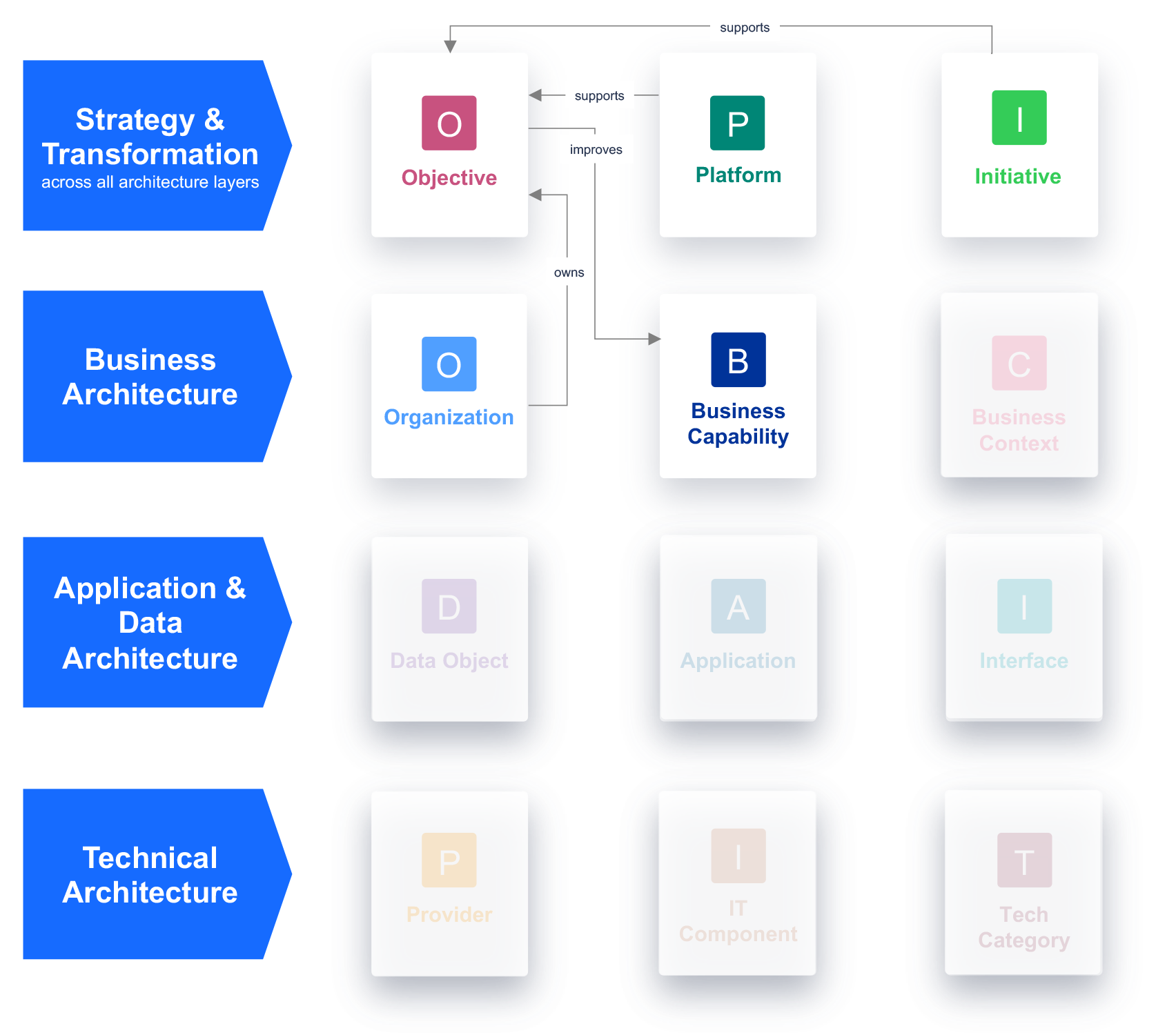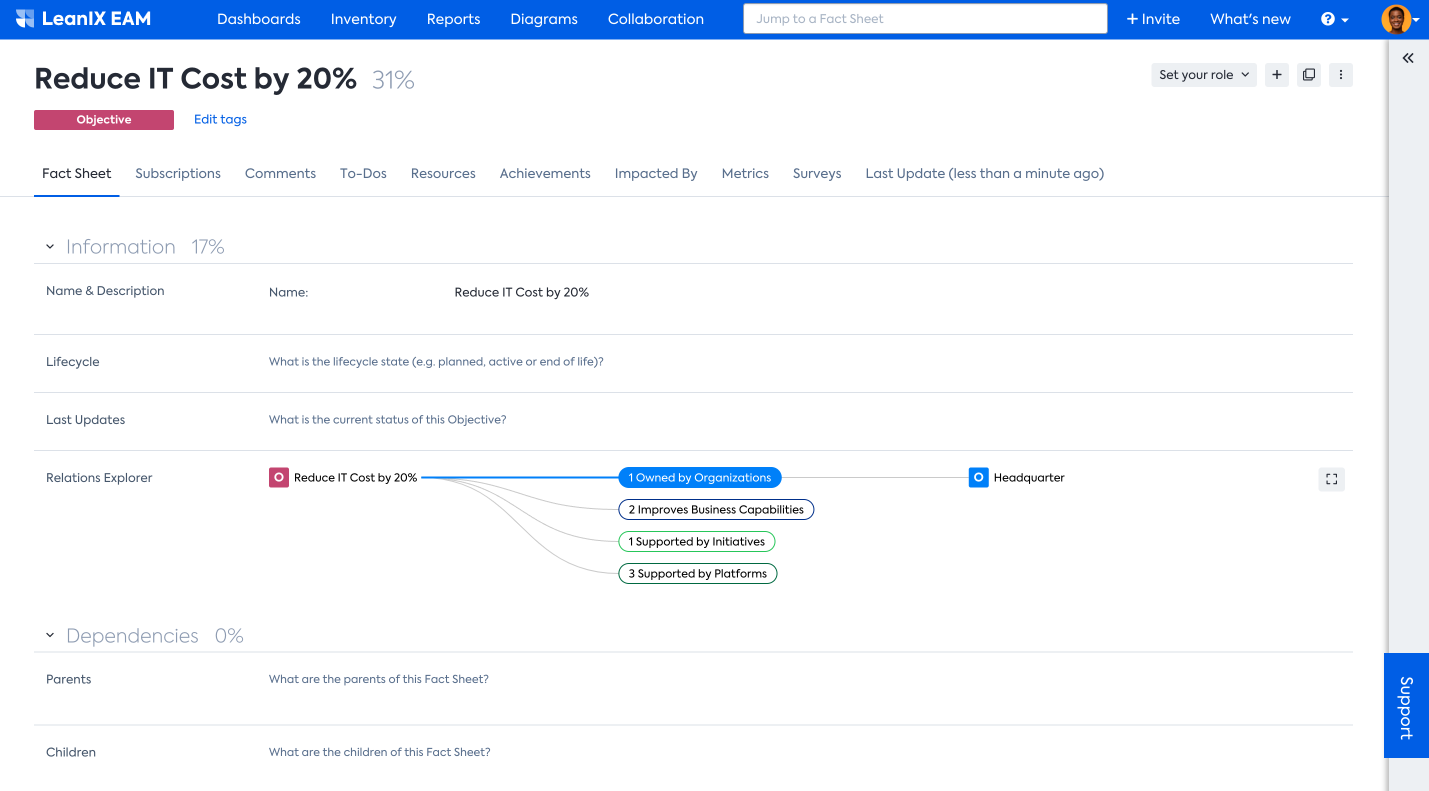Objective Modeling Guidelines
Objective modeling guidelines.
Note
These modeling guidelines are for the Meta Model v4. For Meta Model v3 guidelines, see Modeling: Objectives and Transformation Items (or Projects).
Definition
Objectives describe what an organization wants to achieve. They drive Initiatives to improve Business Capabilities and transform the IT landscape.
Description
The Objective Fact Sheet defines the Key Performance Indicators (KPIs) that will measure success. Objectives link to Business Capabilities and Initiatives so progress can be tracked over time.
Overview of all relations to/from Objective:

Modeling Objectives is not required to get started with the first SAP LeanIX use case, Application Portfolio Assessment.
Modeling Objectives identifies Business Capabilities that are critical to achieving an organization’s strategy and shows how large modernization or transformation initiatives work together towards a common goal.
Objectives are typically derived from an organization’s strategy or taken from OKRs (Objectives and Key Results).
Objective Examples:
- Business Objective: Reach net-zero carbon emissions by 2030
- IT Objective: Use data centers with a carbon footprint calculator for all cloud solutions
by 2025 - Business Objective: Reduce IT Costs by $10m in FY24
- Business Objective: Improve Operational Efficiency by 20% by March 2025
- Business Objective: Onboard 100 new customers in 2026
Guidelines and Best Practices
- Identify short- or long-term objectives by talking with organization leaders or reviewing strategy documents, mission and vision statements, business plans, or similar resources.
- If your organization uses Objectives and Key Results (OKR), it is recommended to include defined objectives.
- Add a maximum of 2 hierarchy levels.
- Ensure that your Objectives are SMART (specific, measurable, achievable, relevant, and time-bound), e.g., ‘Reduce IT Costs by 20% in 2024’.
- The Objective should include a currency, percentage, or count to ensure it is measurable.
- As an Enterprise Architect, work with stakeholders to:
- identify Business Capabilities improved by Objectives.
- define Initiatives that work together to achieve a common Objective.
- use the SAP LeanIX Architecture and Road Map Planning to:
- model Transformations and IT landscape impacts.
- visualize roadmaps and IT landscape changes over time.
- track Initiative progress, reflect changes as they’re delivered, and report on achievement of Objectives.
- Differentiate Objectives from Initiatives. Objectives represent the business goals, while Initiatives capture transformation activities to reach the goals. In the example “A company wants to move internal applications into the cloud by 2025 to increase IT efficiency by 20%”, the first part, “move internal applications into the cloud by 2025,” is the Initiative, and "increase IT efficiency by 20% [by 2025]” is the Objective.
How to model relations between Objectives and other Fact Sheets
The image below shows the Relations Explorer view in an exemplary Objective Fact Sheet. This shows the Objective is linked to other Fact Sheet types such as Organization, Business Capability, Initiative, and Platform.

SAP LeanIX is currently working on a Jira integration to provide better visibility into the execution of your transformation initiatives and track/visualize the impact on your enterprise architecture. Read more and feel free to vote and provide feedback in our SAP LeanIX Product Roadmap.
Antipatterns
This section addresses antipatterns involving ineffective or counterproductive ways of modeling Objectives in SAP LeanIX.
- SAP LeanIX is not an OKR or scorecard tool. Do not manage the progress status of OKRs or track organization performance over time in SAP LeanIX.
Applicable Use Cases
Use Objectives in the following use cases:
- Application Rationalization Step 1
- Application Modernization Step 1
- ERP transformation
Insights from Objective Fact Sheet
Answer the following questions with SAP LeanIX Reports based on the Objective Fact Sheet:
- What are the organization’s objectives?
- Which business unit is accountable for achieving an objective?
- Which business capabilities are critical to achieving organizational objectives?
- Which initiatives contribute to achieving an objective, and what is the impact on the IT landscape over time?
Related Information
Updated about 1 month ago
